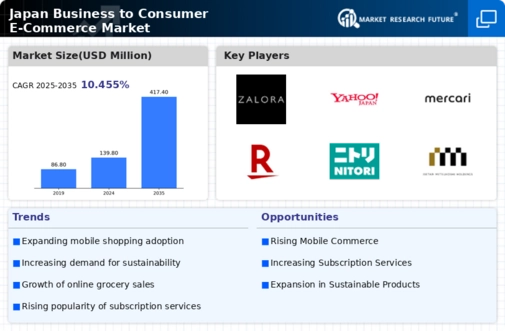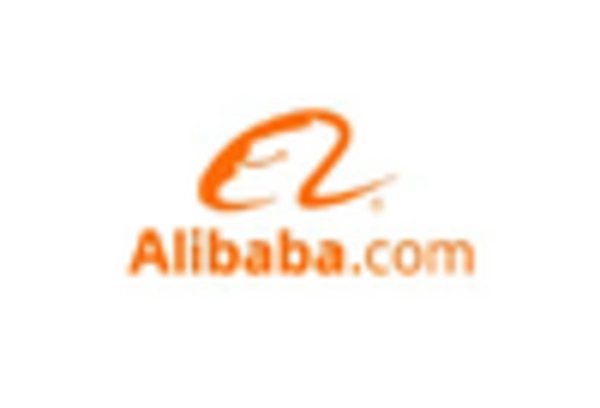The business to-consumer-e-commerce market in Japan is characterized by a dynamic competitive landscape, driven by rapid technological advancements and shifting consumer preferences. Major players such as Amazon (US), Rakuten (JP), and Alibaba (CN) are at the forefront, each employing distinct strategies to capture market share. Amazon (US) continues to innovate its logistics and delivery systems, enhancing customer experience through faster shipping options and personalized recommendations. Rakuten (JP), on the other hand, focuses on integrating its e-commerce platform with its financial services, creating a seamless ecosystem for consumers. Meanwhile, Alibaba (CN) leverages its vast data analytics capabilities to optimize inventory management and enhance user engagement, indicating a trend towards data-driven decision-making in the sector.
The market structure appears moderately fragmented, with a mix of established giants and emerging players. Key tactics such as localizing manufacturing and optimizing supply chains are prevalent among these companies, allowing them to respond swiftly to consumer demands. The collective influence of these major players shapes a competitive environment where agility and innovation are paramount. As companies strive to differentiate themselves, the emphasis on localized strategies and efficient logistics becomes increasingly critical.
In October 2025, Amazon (US) announced the expansion of its Prime Air drone delivery service in Japan, aiming to reduce delivery times to under 30 minutes for select products. This strategic move not only enhances customer satisfaction but also positions Amazon (US) as a leader in last-mile delivery solutions. The integration of drone technology into their logistics framework could potentially revolutionize the delivery landscape, setting a new standard for speed and efficiency in the market.
In September 2025, Rakuten (JP) launched a new initiative to promote sustainable shopping by partnering with local eco-friendly brands. This initiative reflects a growing consumer preference for sustainability and positions Rakuten (JP) as a socially responsible player in the e-commerce space. By aligning its brand with environmental values, Rakuten (JP) may attract a broader customer base, particularly among younger consumers who prioritize sustainability in their purchasing decisions.
In August 2025, Alibaba (CN) unveiled its latest AI-driven recommendation engine, designed to enhance the shopping experience for Japanese consumers. This technology aims to provide personalized product suggestions based on user behavior and preferences, potentially increasing conversion rates. The deployment of advanced AI solutions indicates a broader trend towards personalization in e-commerce, where understanding consumer behavior becomes essential for driving sales.
As of November 2025, the competitive trends in the business to-consumer-e-commerce market are increasingly defined by digitalization, sustainability, and AI integration. Strategic alliances among companies are shaping the landscape, fostering innovation and collaboration. The shift from price-based competition to a focus on technology, supply chain reliability, and customer experience is evident. Moving forward, competitive differentiation will likely hinge on the ability to leverage technology and sustainability initiatives, as companies seek to meet the evolving expectations of consumers.

















Leave a Comment